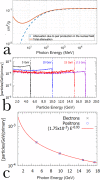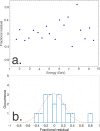Conceptual Design of a High-flux Multi-GeV Gamma-ray Spectrometer
- PMID: 32555398
- PMCID: PMC7303163
- DOI: 10.1038/s41598-020-66832-x
Conceptual Design of a High-flux Multi-GeV Gamma-ray Spectrometer
Abstract
We present here a novel scheme for the high-resolution spectrometry of high-flux gamma-ray beams with energies per photon in the multi-GeV range. The spectrometer relies on the conversion of the gamma-ray photons into electron-positron pairs in a solid foil with high atomic number. The measured electron and positron spectra are then used to reconstruct the spectrum of the gamma-ray beam. The performance of the spectrometer has been numerically tested against the predicted photon spectra expected from non-linear Compton scattering in the proposed LUXE experiment, showing high fidelity in identifying distinctive features such as Compton edges and non-linearities.
Conflict of interest statement
The authors declare no competing interests.
Figures






References
-
- Di Piazza A, Muller C, Hatsagortsyan Z, Keitel CH. Extremely high-intensity laser interactions with fundamental quantum systems. Rev. Mod. Phys. 2012;84:1177. doi: 10.1103/RevModPhys.84.1177. - DOI
-
- Schumaker W, et al. Measurements of high-energy radiation generation from laser-wakefield accelerated electron beams. Phys. Plasmas. 2014;21:056704. doi: 10.1063/1.4875336. - DOI
LinkOut - more resources
Full Text Sources

